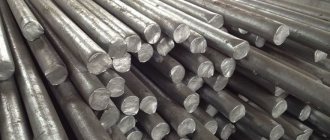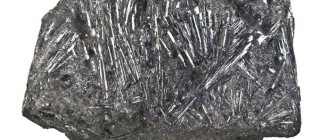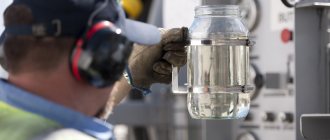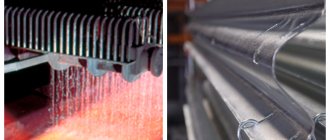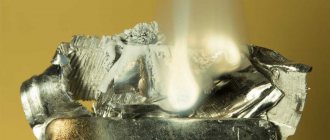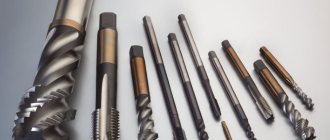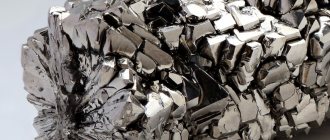Vk3
19 6522 1176(120) 15.0-15.3 89.5 VK6 19 6524 1519(155) 14.6-15.0 88.5 VK3-M 19 6511 1176(120) 15.0-15.3 91 .0 VK6M 19 6512 1421(145) 14.8-15.1 90.0 VK6-OM 19 6516 1274(130) 14.7-15.0 90.5 VK6-V 19 6532 1666(170) 14.6 -15.0 87.5 VK8 19 6525 1666(170) 14.5-14.8 88.0 VK8-V 19 6533 1813(185) 14.4-14.8 86.5 VK8-VK 19 6535 1764( 180) 14.5-14.8 87.5 VK10 19 6526 1764(180) 14.2-14.6 87.0 VK10-KHOM 19 6552 1470(150) 14.3-14.7 89.0 VK4- В 19 6531 1470(150) 14.9-15.2 88.0Characteristics of hard alloys
Characteristics determine their properties and scope of application. These include:
- name and percentage of chemical elements;
- physical and mechanical properties;
- features of technological production processes;
The chemical composition and percentage of main elements are determined according to GOST tables.
Production of hard alloys
Physical and mechanical characteristics include:
- permissible strength, which is checked by bending (varies from 1200 MPa VK2, to 2150 MPa for alloy VK25);
- hardness (increases from 89.5HRA - VK3, reaches 91 HRA - TT20K9);
- density (this indicator ranges from 14.9 g/cm3 to 15.2 g/cm3);
- realized thermal conductivity - about 51 W/(m×°C);
- heat resistance;
- corrosion resistance.
The given list of characteristics allows you to determine the scope of use.
Vk11-v
19 6534 1960(200) 14.1-14.4 86.0 VK10-KS 19 6536 1862(190) 14.2-14.6 85.0 VK20 19 6528 2058(210) 13.4-13.7 84 .0We are glad to welcome you to the pages of our website.
We produce technological equipment:
- Mandrels with a 7:24 cone for mounted end mills GOST 26538-85
- Mandrels with a supporting sleeve and a shank with a taper of 7:24 for horizontal milling machines GOST 15068-75
- Adapter bushings with a taper of 7:24 for end mills with a conical shank GOST 13790-68 with a shank version in accordance with GOST 25827-93 (1,2,3)
- Adapter bushings with a taper of 7:24 for a drill with a conical shank with a shank design in accordance with GOST 25827-93 (1,2,3)
- Chucks for quick-change tools GOST 14077-83
- Quick-change rigid adapter bushings GOST 13409-83 without ring
- Rulers 500 mm GOST 427-75
- Center thrust with taper 1:7 GOST 18259-72
- Center of rotation with Morse taper 1Н, 2Н,3Н,3У,4Н,4У,5Н,5У,6Н,6У, Met80, Met 100
- Thrust centers with Morse taper KM0, KM1, KM2, KM3, KM4, KM5, KM6, Met80, Met 100
- Fungal centers with different attachments and different types of manufacturing.
- The center of rotation for CNC uses high-speed bearings.
- Thrust half center and thrust center with release nut.
- Adapter bushings from a larger Morse cone to a smaller Morse cone.
- Adapter sleeves extended from a large Morse taper to a smaller Morse taper.
- Adapter sleeves extended from a smaller Morse taper to a larger Morse taper.
- Mandrels for drill chuck with shortened cone.
- Bushings for end mills.
- Bushings for quick-change chucks.
- Grooved thrust centers.
- Control mandrels.
We produce non-standard products according to customer drawings related to our production profile, for example, we can produce a spindle for a tabletop drilling machine using a drill chuck with a shortened cone B. We produce test mandrels with KM2, KM3, KM4, KM5, KM6, Met140 and cylindrical test mandrels. We stopped making large volumes, we have a large assortment and we became interested in making our products last as long as possible, because it is very difficult to maintain the range of products, there is a lot of changeover. The technical characteristics of the rotation centers of our production significantly exceed the characteristics of the rotation centers of other manufacturers. This is evidenced by the analysis we conducted of disassembled rotation centers from manufacturers: China, Bison, Orsha and our products. The results of the analysis reveal the real advantages of our rotation centers. This analysis cannot be provided by any other trading organization. We are currently moving to a quality level corresponding to the European level.
Sincerely, Director of Instrument Saransky LLC E.A. Maltsev
Vk11-vk
19 6537 1862(190) 14.1-14.4 87.0 VK15 19 6527 1862(190) 13.9-14.4 86.0 VK20-KS 19 6538 2107(215) 13.4-13.7 82 .0 Titanium tungsten T30K4 19 6614 980(100) 9.5-9.8 92.0 T15K6 19 6613 1176(120) 11.1-11.6 90.0 T14K8 19 6612 1274(130) 11.2-11, 6 89.5 T5K10 19 6611 1421(145) 12.5-13.1 88.5 Titanium tantalum tungsten TT7K12 19 6621 1666(170) 13.0-13.3 87.0 TT8K6 19 6623 1323(135) 12.8- 13.3 90.5 TT10K8B 19 6622 1617(165) 13.5-13.8 89.0 TT20K9 19 6624 1470(150) 12.0-12.5 91.0 T8K7 19 6616 1519(155) 12.8 -13.1 90.5(Changed edition, Amendment
No. 1, 3, 4, 6).
3. The scope of application of hard alloys is indicated in Appendix 1.
4. The classification of grades of hard alloys for processing materials by cutting in accordance with the international standard ISO 513 and ST SEV 5015 is given in Appendix 2.
The groups of use of hard alloys for mining tools are designated in accordance with ST SEV 1251 and are given in Appendix 3. Designations of alloy grades according to national standards are given in Appendix 4.
(Changed edition, Amendment No. 2, 3, 5).
| Stamps | Application |
| For processing materials by cutting | |
| vk3 | Finish turning with a small shear section, final threading, reaming holes and other similar types of processing of gray cast iron, non-ferrous metals and their alloys and non-metallic materials (rubber, fiber, plastic, glass, fiberglass, etc.). Sheet glass cutting |
| vk3-m | Finishing (turning, boring, threading, reaming) of hard, alloyed and bleached cast irons, case-hardened and hardened steels, as well as highly abrasive non-metallic materials. |
| VK6-OM | Finishing and semi-finishing of hard, alloyed and bleached cast irons, hardened steels and some grades of stainless high-strength and heat-resistant steels and alloys, especially alloys based on titanium, tungsten and molybdenum (turning, boring, reaming, threading, scraping). |
| VK6-M | Semi-finishing of steam-resistant steels and alloys, austenitic stainless steels, special hard cast irons, hardened cast iron, hard bronze, light metal alloys, abrasive non-metallic materials, plastics, paper, glass. Processing of hardened steels, as well as raw carbon and alloy steels with thin cut sections at very low cutting speeds. |
| TT8K6 | Finish and semi-finish turning, boring, milling and drilling of gray and ductile cast iron, as well as bleached cast iron. Continuous turning with small shear sections of cast steel, high-strength, stainless steels, including hardened ones. Processing of non-ferrous metal alloys and some grades of titanium alloys when cutting with small and medium cut sections. |
| VK6 | Rough and semi-rough turning, preliminary thread cutting with turning tools, semi-finish milling of solid surfaces, drilling and boring holes, countersinking of gray cast iron, non-ferrous metals and their alloys and non-metallic materials. |
| VK8 | Rough turning with uneven cut section and intermittent cutting, planing, rough milling, drilling, rough drilling, rough countersinking of gray cast iron, non-ferrous metals and their alloys and non-metallic materials. Processing of stainless, high-strength and heat-resistant difficult-to-machine steels and alloys, including titanium alloys. |
| VK10-HOM | Drilling, countersinking, reaming, milling and gear hobbing of steel, cast iron, some difficult-to-cut materials and non-metals with solid carbide, small-sized tools. |
| VK15 | Cutting tools for wood processing. |
| T30K4 | Finish turning with a small cut section (diamond cutting type); thread cutting and reaming of unhardened and hardened carbon steels. |
| T15K6 | Semi-rough turning during continuous cutting, finishing turning during interrupted cutting, threading with commercial cutters and rotary heads, semi-finishing and finishing milling of solid surfaces, drilling and boring of pre-machined holes, finishing countersinking, reaming and other similar types of processing of carbon and alloy steels. |
| T14K8 | Rough turning with an uneven cut section and continuous cutting, semi-finish and finishing turning with intermittent cutting; rough milling of solid surfaces; drilling cast and forged holes, rough countersinking and other similar types of processing of carbon and alloy steels. |
| T5K10 | Rough turning with uneven cut section and intermittent cutting, shaped turning, cutting with turning tools; finishing planing; rough milling of discontinuous surfaces and other types of processing of carbon and alloy steels, mainly in the form of forgings, stampings and castings on crust and scale. |
| TT7K12 | Heavy rough turning of steel forgings, stampings and castings on shells with shells in the presence of sand, slag and various non-metallic inclusions, with an uneven cut section and the presence of impacts. All types of planing of carbon and alloy steels. Drilling holes in steel. |
| TT7K12 | Heavy rough turning of steel forgings, stampings and castings on shells with shells in the presence of sand, slag and various non-metallic inclusions with a uniform cut section and the presence of impacts. All types of planing of carbon and alloy steels. Heavy rough milling of carbon and alloy steels. |
| TT10K8-B | Roughing and semi-finishing of certain grades of hard-to-cut materials, austenitic stainless steels, low-magnetic steels and heat-resistant steels and alloys, including titanium. |
| TT20K9 | Milling of steel, especially milling of deep grooves and other types of processing that place increased demands on the resistance of the alloy to thermal and mechanical cyclic loads. |
| T8K7 | When milling difficult-to-cut cast irons. |
| For equipping mining tools | |
| VK6 | Rotary drilling of geological exploration, production and blasting holes and wells in monolithic and abrasive rocks with a strength coefficient on the Protodyakonov scale of up to f = 8. |
| VK6-V | Rotary impact drilling of holes in rocks with a strength coefficient according to the Protodyakonov scale f = 8. Notches of hard coals with minor inclusions of hard rocks. |
| VK4-V | Drilling with electric and pneumatic drills of coal, anthracite, non-silicified shale, potassium and rock salts; drilling with hand and core electric drills of rocks with a strength coefficient according to the Protodyakonov scale up to f = 8. Reinforcement of roller bits. |
| VK8 | Rotary drilling of geological exploration, production and blasting holes and wells in fractured mineral rocks with a strength coefficient on the Protodyakonov scale of up to f = 8. Sawing marble and limestone, as well as in stone-cutting machines. |
| VK8-VK | Roller-cone drilling of geological exploration, production and blasting wells in strong and very strong abrasive rocks with a strength coefficient on the Protodyakonov scale of up to f = 18. |
| VK8-V | Impact-rotary, impact-rotary and rotary-percussion drilling of holes and wells in hard rocks with a strength coefficient on the Protodyakonov scale up to f = 14 Notches of hard coals with the inclusion of hard rocks. Processing of granites and rocks of similar strength. |
| VK11-VK | Roller-cone drilling of geological exploration, production and blasting holes and wells in viscous, medium-hard and hard abrasive rocks with a strength coefficient according to the Protodyakonov scale f = 10. |
| VK11-V | Impact-rotary, impact-rotary, rotary-percussion drilling of holes and wells in very strong and abrasive rocks with a strength coefficient on the Protodyakonov scale up to f = 18. |
| BK15 | Impact-rotary, impact-rotary drilling of holes and wells in extremely strong rocks with a strength coefficient on the Protodyakonov scale of up to f = 20. |
| BK15 | Processing granite and other rocks using pneumatic hammers. |
| For chip-free processing of metals, wear parts of machines, instruments and fixtures | |
| VK3, VK3-M, VK4, VK6, VK6-M | Dry drawing of wire made of steel, non-ferrous metals and their alloys with a small degree of compression. Wearing parts of machines, instruments and measuring instruments operating without shock loads. |
| VK8 | Drawing, calibration and pressing of rods and pipes made of steel, non-ferrous metals and their alloys. Wearing parts of machines, instruments and measuring instruments operating under low shock loads. |
| VK10 | Drawing and calibration of rods and pipes made of steel, non-ferrous metals and their alloys at an average degree of reduction. Wearing parts of machines, instruments and measuring instruments operating under moderately intense shock loads. |
| VK15 | Drawing and pressing of steel rods and pipes at an increased degree of compression. Stamping, upsetting, trimming, drawing of carbon and high-quality steels under low-intensity impact loads. |
| VK20 | Stamping, upsetting, cutting of carbon and high-quality steels under shock loads of medium and high intensity. |
| VK10-KS | Stamping, upsetting, drawing of alloy and special steels under low-intensity impact loads. |
| BK20-KC | Stamping, upsetting, trimming of alloy and special steels and alloys under medium-intensity impact loads. |
ANNEX 1.
(
Amended edition, Rev. No. 1, 6).
| Main cutting groups | Application groups | Changing the cutting mode | Changing the properties of hard alloys | |||
| Designation | Marking color | Designation | Processed material and type of chips removed | Type of treatment and conditions of use | ||
| R | Blue | P10 | Steel, cast steel, producing draining chips | Turning, copy turning, threading, milling, drilling, boring | ||
| P20 | Steel, cast steel, ductile iron and non-ferrous metals producing drain chips | Turning, copy turning, milling, fine planing | ||||
| P25 | Unalloyed, low and medium alloy steel | Milling, including milling of deep grooves, other types of processing that place increased demands on the alloy’s resistance to thermal and mechanical loads | ||||
| P30 | Steel, cast steel, ductile iron, producing drain chips | Rough turning, milling, planing. For work in adverse conditions* | ||||
| P40 | Steel, steel casting with sand inclusions and shells, producing drain and fracture chips | Rough turning, planing. For work in particularly unfavorable conditions* | ||||
| P50 | Steel, cast steel with medium or low strength, with sand inclusions and cavities, producing drain and fracture chips | Turning, planing, chiselling with particularly high requirements for the strength of the carbide due to unfavorable cutting conditions*. For tools with complex shapes | ||||
| M | yellow | M10 | Steel, steel casting, high-alloy steels, including austenitic ones, heat-resistant difficult-to-machine steels and alloys, gray, malleable and alloyed cast irons, which produce both drain and fracture chips | Turning and milling | ||
| M20 | Cast steel, austenitic steels, manganese steel, heat-resistant difficult-to-machine steels and alloys, gray and malleable cast iron, producing both drain and fracture chips | Turning and milling | ||||
| M30 | Cast steel, austenitic steels, heat-resistant difficult-to-cut steels and alloys, gray and malleable cast irons that produce both drain and fracture chips | Turning, milling, planing. Unfavorable cutting conditions* | ||||
| M40 | Low-carbon steel with low strength, free-cut steel and other metals and alloys that produce both drain and fracture chips | Turning, shaped turning, parting mainly on automatic machines | ||||
| TO | red | K01 | Gray cast iron, predominantly of high hardness, aluminum alloys with a high silicon content, hardened steel, abrasive plastics, ceramics, glass, which produce chips that break | Finish turning, boring, milling, scraping | ||
| K05 | Alloyed and bleached cast irons, hardened steels, stainless high-strength and heat-resistant steels and alloys that produce chips that break | Fine and semi-finish turning, boring, reaming, thread cutting | ||||
| K10 | Gray and malleable cast iron, mainly of high hardness, hardened steel, aluminum and copper alloys, plastics, glass, ceramics, which produce chips that break | Turning, boring, milling, drilling, scraping | ||||
| K20 | Gray cast iron, non-ferrous metals, highly abrasive pressed wood, plastics that produce chips | Turning, milling, planing, drilling, boring | ||||
| K30 | Gray cast iron of low hardness and strength, low strength steel, wood, non-ferrous metals, plastics, dense wood that produces chips that break | Turning, milling, planing, drilling. Working in unfavorable conditions *. Large rake tool sharpening angles are acceptable | ||||
| K40 | Non-ferrous metals, wood, plastics that produce chips that break | Turning, milling, planing. Large rake tool sharpening angles are acceptable | ||||
____________
Unfavorable working conditions should be considered work with a variable depth of cut, with intermittent feed, with shocks, vibrations, with the presence of casting skin and abrasive inclusions in the material being processed.
Depending on the material being processed and the type of chips being removed, hard sintered alloys are divided into three main cutting groups: P, M and K.
Depending on the types and modes of cutting, the main cutting groups are divided into application groups in accordance with Appendix 2.
Application groups are designated by the letter of the main cutting group and a numerical index, which characterizes the change in the type of processing, cutting mode and properties of the hard alloy.
The higher the index number in the designation of the application group, the lower the wear resistance of the carbide and the permissible cutting speed, but the higher the strength of the carbide and the permissible feed and depth of cut during cutting.
In addition to the application groups established in this standard, it is allowed to additionally establish no more than one intermediate application group, the numerical index of which must be intermediate between two adjacent application groups, for example K15 (between K10 and K20).
Application group P01 can be subdivided using the following designations: P01.1; P01.2 and P01.3.
The introduction of intermediate application groups is possible only if the hard alloy differs significantly in wear resistance and strength from alloys belonging to neighboring application groups.
The designation of grades of hard alloys should not coincide with the designation of the main cutting group and application group.
The letter “C” is added to the designation of the group of use of coated hard alloys, for example, P30C; K20S.
Data on belonging to the application groups of hard alloy grades established in the standards of the CMEA member countries is given in Appendix 5.
APPENDIX 2.
(Changed edition, Amendment No. 5).
| Designation according to ST SEV | Application area | Changing the properties of hard sintered alloys | |
| Group | Subgroup | ||
| IN | 01 | Rotary drilling of soft rocks: shale, gypsum, potassium and rock salts, etc., coal cutting | |
| 10 | Rotary, rotary impact drilling of monolithic and fractured rocks: limestone, dolomite, marble, coal, rock salt, etc. Cutting hard coals with minor inclusions of hard rocks | ||
| 15 | Roller drilling of strong and very strong abrasive rocks: quartzite, strong granite, siliceous shale, etc. | ||
| 20 | Impact-rotary and impact-rotary drilling of strong rocks: dense granite, strong sandstones, limestone and quartzite, strong iron ores, etc. Cutting hard coals with inclusion of hard rocks | ||
| 25 | Roller drilling of viscous, medium-hard abrasive rocks: dense marl, shale, etc. | ||
| 30 | Impact-rotary and impact-rotary drilling of strong and very strong abrasive rocks: strong granite rocks, quartzites, very strong granites, etc. | ||
| 40 | Impact-rotary, impact-rotary drilling of the strongest rocks, the strongest, densest and most viscous quartzites, etc. | ||
APPENDIX 3.
(Changed edition, Amendment No. 5).
| Designation according to ST SEV | Grades of hard sintered alloys according to national standards of CMEA member countries in accordance with application groups | |||||||||
| Group | ||||||||||
Classification
The variety of such materials requires a clear division according to their characteristic features. Classification of hard alloys is made according to the following criteria:
- composition of chemical elements (name, percentage);
- on production technology;
- Areas of use.
Based on the chemical elements present, they are divided into the following categories:
- tungsten-cobalt (marking VK);
- titanium-tungsten-cobalt (TC);
- titanium-tantalum-tungsten-cobalt (TTK).
According to the production technologies used, they are divided into: sintered, cast, and powdered. Sintered, composed of carbides. Divided into three groups:
- single-carbide (tungsten carbide);
- two-carbide (including carbides of two metals: titanium and tungsten);
- tricarbide (welded from three elements).
Based on the percentage content of each element, they are divided into the following groups.
The first includes materials consisting of tungsten carbide and cobalt. They are designated VK. This large group includes alloys: VK4, VK3M, VK6M. The hard alloy VK8 and VK3 is very popular. VK3 stands for the same as all tungsten alloys.
The second combines titanium-tungsten alloys. It has the abbreviation TK. These include: T5K10, T14K8.
The third includes all titanium tantalum tungsten alloys. Designated TTC. For example, TT7K12 and others.
The fourth combines materials that have a wear-resistant coating. They are designated by the abbreviation VP. It includes: VP3115, VP3325. Each of them is based on a well-known alloy. For example, VPZ115 has a base of VK6.
Tungsten-containing hard alloys
They are marked as follows - VK6, VKZM, VK6M, VK8. The main area of application is the production of cutting tools. Alloy VK8 is used for the manufacture of cutters.
Set of tips VK6
It allows you to process cast iron. Used for the production of tools capable of so-called chip-free processing of materials.
Titanium-tungsten-containing hard alloys
Tools for high-speed processing of various types of steel are made from grades T5K10, T14K8, T15K6. They are used to process metals and various compounds with increased hardness and heat resistance.
The most typical example of such a tool are various types of cutters and drill cores.
Subgroup
USSR People's Republic of Belarus Hungary People's Republic GDR Republic of Cuba MPR People's Republic of Poland SRR Czechoslovakia V 01 VK6 - DB 10 HG 20 - - in - G 1 10 VK6VVK8
— DB20 HG 20HG 30
— — B1 — G 1.1 15 VK8VK — — — — — B1 — — 20 VK8V — DB25VK11V
— DB30 HG 40 — — В45 — G 2 40 ВК15 — DB40 HG 40 — — В45 — G 3APPENDIX 4
. (Introduced additionally, Amendment No. 2).
| Application group | ||||||
